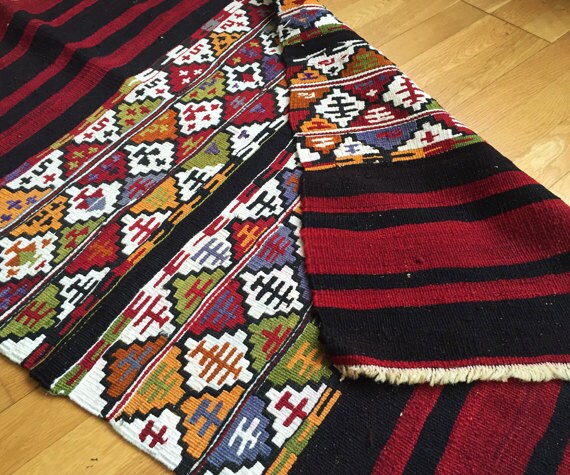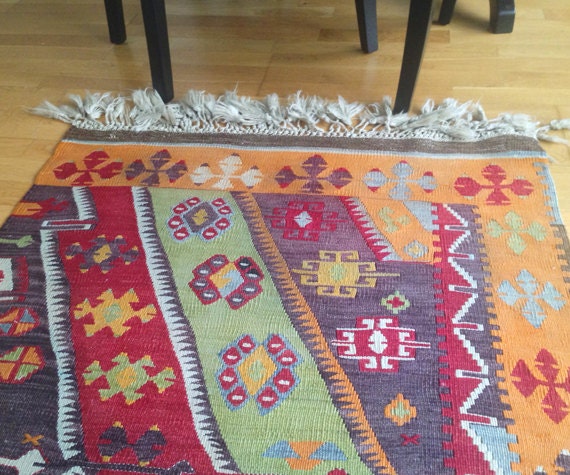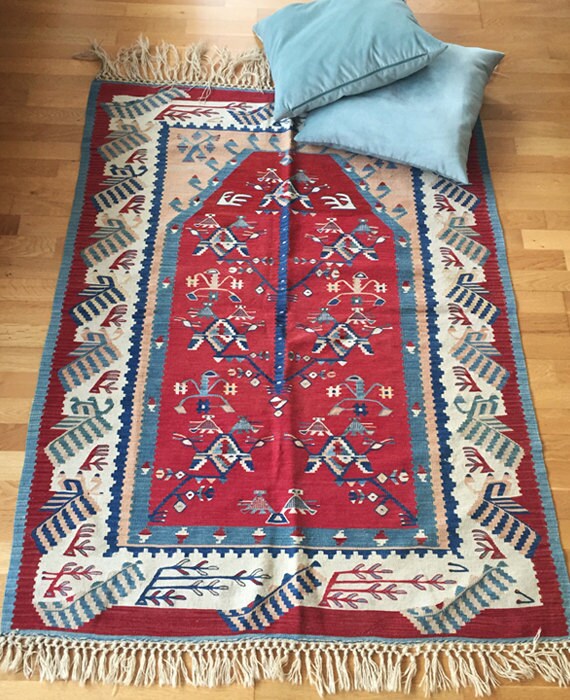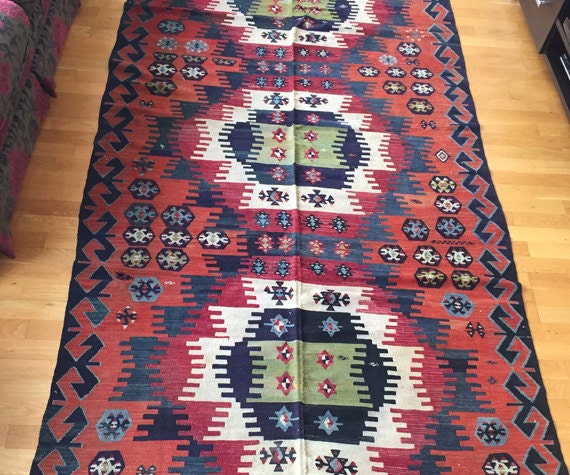Kilim's Life: A Video About Anatolian Kilims.
Unknown
I do many restorations for old carpet or kilims or industry and between 100 years old early 13th-century Ottoman pieces, I make the recovery.
Many, in center Anatolia, is a unique design are from Konya, Sivas, Aksaray. This three area a very unusual design and color combination.
All these areas, at same times many different tribes. These tribes are before like twenty years ago in Turkey a lots tribes. Now you can see maybe one or two tribes still there in tradition. Most of the nomadic they settle the Highland they don’t travel anymore.
Before like my families like nomadic before I remember each has in the village in the Highland have they do own handmade carpet. Now is nobody can do anymore.
If you wish, you can watch more from the video below.
5/22/2016
anatolian
,
antique rug
,
etsy seller
,
kilim
,
kilimadvisor
,
rugs motif
,
runners
,
turkish kilims
,
vintage
Kilim's Life: An Interview with Hamit Balkir
Unknown
We made an interview with Hamit Balkır. He has already owned a Kilim Carpet Shop, whose name is Motif Collection, in Sultanahmet, Istanbul. Thank him for his answers.
You are a specialist in antique Turkish and Anatolian carpet and kilim repair. Could you please introduce yourself and your company? How did you start your job? How many are people working with you?
I started to learn repairing of carpets and kilims at an atelier when I was 12 years old. After 4 years later, I opened my own repair atelier. Now four people are working with me.
How many kilims or rugs did you repair until today?
More than 10,000.
Is there any difference between repairing kilims and carpets?
Very different. Kilim is flat woven. Turkish carpets are double knotted. Repairing of carpets is more difficult than that of kilims.
Is there any difference between hand woven old carpets and the new ones?
They are completely different. New carpets are tough like cardboard. Old ones are softer and more beautiful. In old times, people used to weave carpets and kilims for their family and themselves. They did all the processes like spinning, dyeing and weaving by their own hands with natural materials. Old ones are different from each other.
Does Repair Affect a Carpet’s Value?
Bad repair can affect. We usually use old threads for repair.
What kind of attention should you pay when you're repairing antique carpets and kilims?
Old carpet and kilims are very delicate. They need more care.
How long does it take to repair a carpet? How do you determine the repairing time?
Depending on the conditions of carpets.
Is there any difference between repairing silk carpets and wool carpets?
Very different, of course. The repair of silk carpets is more difficult than wool ones.
How should we protect our antique carpets and kilims after the restoration?
We shouldn't use them in the high traffic area.
What would you like to say to carpet and kilim lovers and to the readers?
All of the handmade tribal carpets and kilims are valuable. Most of them will have value as antique in the future.
Finally, how can the buyers reach to you?
I’ve been repairing kilims and carpets and selling them to local people and tourists at our shop in Istanbul for years. Today, all the people want to buy anything easily from all over the world.
Online sales are the future, we have to join it. Kilim Advisor was established only two months ago.
Now it’s our current e-commerce project on Etsy.com, which is the best web site for handmade and vintage. You can find many kilim and carpet pillows, bags, saddle bags, etc. in this online shop. We offer you elegant and special antique carpets and kilims at reasonable prices. We have some plans for next. Hope to see you again with the different projects.
-----------------
Please follow us from below link:
https://www.etsy.com/shop/KilimAdvisor
Friend us on Facebook: facebook.com/KilimAdvisor
Follow us on Twitter: twitter.com/kilim_advisor
Follow us on Instagram: instagram.com/kilimadvisor
Follow us on Pinterest: pinterest.com/kilimadvisor
Hamit Balkır's Facebook account: https://www.facebook.com/motif.kilim.9
Thanks for reading. If you like this content, please post a comment.
We are reading all messages and feedbacks.
Kilim Advisor
4/21/2016
antique rug
,
etsy seller
,
kilimadvisor
,
rug repairing.
,
runners
,
turkish kilims
,
turkish rugs
,
vintage
How to Protect Your Kilim Rugs
Unknown
We all are loving to use kilims at home while decorating our living room, kitchen or bedroom. Of course, they change the atmosphere wherever you use. Because all of them unique and charming. Especially Anatolian kilims. They are magical to have bright colors.
So, do you know to protect your kilims and rugs? It's important to use them long years.
How to Use:
1. Sweep your carpets and kilims using vacuum cleaner gently once a week and thoroughly once a month.
2. Protect your kilims and rugs against moisture or wetness.
3. It is important to rotate your carpet periodically to avoid continually walking over the same spots, and causing wear patterns to develop.
4. Avoid direct sunlight on handmade carpets.
5. Reposition your large furniture or stuff on your kilims or rugs.
6. It is important periodically to inspect your carpets and kilims.
2. Use soap-free synthetic material or baby shampoo with cold water for washing your carpets.
3. After washing your carpets, dry in the shade and avoids direct sunlight.
4. It’s important to protect against wetness.
5. Get immediate intervention against stains that may occur.
6. Clean the stain on your kilims and rugs to start toward the center from the outer periphery.
7. Do NOT use detergent, bleach, etc. for washing your rug's fringes.
8. Do NOT pressing or scrubbing while it cleaning.
9. Do NOT wash your kilims or rugs by pressing or scrubbing.
10. Do NOT use detergent, bleach, etc. for washing your rugs and kilims.
11. Do NOT use a washing machine.
12. Do NOT use tumble dry.
 |
| Please click here to see |
How to Use:
1. Sweep your carpets and kilims using vacuum cleaner gently once a week and thoroughly once a month.
2. Protect your kilims and rugs against moisture or wetness.
3. It is important to rotate your carpet periodically to avoid continually walking over the same spots, and causing wear patterns to develop.
4. Avoid direct sunlight on handmade carpets.
5. Reposition your large furniture or stuff on your kilims or rugs.
6. It is important periodically to inspect your carpets and kilims.
 |
| Please click here to see |
How to Care:
1. Wash your kilims and rugs with your hand or give it to the professionals person for washing.2. Use soap-free synthetic material or baby shampoo with cold water for washing your carpets.
3. After washing your carpets, dry in the shade and avoids direct sunlight.
4. It’s important to protect against wetness.
5. Get immediate intervention against stains that may occur.
6. Clean the stain on your kilims and rugs to start toward the center from the outer periphery.
7. Do NOT use detergent, bleach, etc. for washing your rug's fringes.
8. Do NOT pressing or scrubbing while it cleaning.
9. Do NOT wash your kilims or rugs by pressing or scrubbing.
10. Do NOT use detergent, bleach, etc. for washing your rugs and kilims.
11. Do NOT use a washing machine.
12. Do NOT use tumble dry.
4/15/2016
anatolian
,
kilim
,
kilimadvisor
,
rugs motif
,
runners
,
turkish kilims
,
turkish rugs
Anatolian Rug and Weaving
Unknown
Kilim and Runner are a very important part of Turkish hand-woven art. The reason is that Turks, engaged in animal husbandry were living a nomadic life in the past and use kilims every moment of their life. Today, Anatolian Rug remain important.
For Centuries, Anatolian people’s thoughts, dreams and hopes were expressed with the colors and motifs weaved in the rugs. Rope woven from wool and cotton kilims and runners, upholstery, sofas and ottomans are an important part of laying places such as home decoration.
The Ottoman era today, Anatolian rug were weaving by hand. The dyes used for centuries fade, protects colors and patterns. The dye is obtained by boiling the plant roots. Generally, looms woven rugs are made from tree traditional motifs and carries the colors and patterns of their villages.
In Anatolia, Turkish rugs and runners are usually woven by women. This weaving benches were called “Istar”. There were placed upright or tilted. Weaving benches should take a good environment where light and environment must be good. It must be an empty space to sit in front of the bench.
Turkish rug and runners are divided according to their weaving areas, our herbal dyes and motifs. The most common types of rugs are Turkmen rugs, nomadic rugs and Turkish rugs. Rugs motif reflect region’s culture, weaver’s feelings and dreams.
The most common motif rugs in Anatolia
Hands on waist: Motherhood and fertility’s symbol
Coach Horn: Fortunately, luck, fortune, happiness, joy, long life, is a symbol of bravery and strength.
The hook: the symbol of evil gaze out with pointed ends
Human: Women, men, and fertility’s symbols.
Bandeau: young girls used it to show their marriage request.
Earrings: Weaver put the earring is the description of the family he wanted to marry the girl.
Hand: It is used to protect against the evil eye
Water: It used to be used as a motif.
Eyes: Used as a protective eye
The Tree of Life: Strip symbolizes the immortality
Birds: Luck and bad luck symbolizing motif.
 |
| This rug is at least 90 years old and in good condition. Please click here to see. |
For Centuries, Anatolian people’s thoughts, dreams and hopes were expressed with the colors and motifs weaved in the rugs. Rope woven from wool and cotton kilims and runners, upholstery, sofas and ottomans are an important part of laying places such as home decoration.
The Ottoman era today, Anatolian rug were weaving by hand. The dyes used for centuries fade, protects colors and patterns. The dye is obtained by boiling the plant roots. Generally, looms woven rugs are made from tree traditional motifs and carries the colors and patterns of their villages.
In Anatolia, Turkish rugs and runners are usually woven by women. This weaving benches were called “Istar”. There were placed upright or tilted. Weaving benches should take a good environment where light and environment must be good. It must be an empty space to sit in front of the bench.
 |
| Please click here to see. |
Turkish rug and runners are divided according to their weaving areas, our herbal dyes and motifs. The most common types of rugs are Turkmen rugs, nomadic rugs and Turkish rugs. Rugs motif reflect region’s culture, weaver’s feelings and dreams.
The most common motif rugs in Anatolia
Hands on waist: Motherhood and fertility’s symbol
Coach Horn: Fortunately, luck, fortune, happiness, joy, long life, is a symbol of bravery and strength.
The hook: the symbol of evil gaze out with pointed ends
Human: Women, men, and fertility’s symbols.
Bandeau: young girls used it to show their marriage request.
Earrings: Weaver put the earring is the description of the family he wanted to marry the girl.
Hand: It is used to protect against the evil eye
Water: It used to be used as a motif.
Eyes: Used as a protective eye
The Tree of Life: Strip symbolizes the immortality
Birds: Luck and bad luck symbolizing motif.
4/09/2016
anatolian
,
kilimadvisor
,
rugs motif
,
runners
,
turkish kilims
,
turkish rugs
#kilimadvisor is Online Now!
Unknown
This year we have decided to start online sales on Etsy.com and Kilimadvisor.com.
Our founder Hamit Balkır gave some informations about his work and history.
You can read the story below.
When I was a child, I had known kilim and carpet
When I was in 12 years old, I began to learn repairing carpets and kilims by my brother. After I worked for four years to learn much more, we opened an atelier for repair in Istanbul in 1992. Besides our repairing, my brother and I went to Anatolia to collect antique and old kilims and carpets and started to sell them. Though most of the girls who wove carpets and kilims might haven't been much far from their villages, the motifs they made without seeing anything explain many meanings of life. The more I learnt the meanings of motifs, the more important part of my life they became.
We are selling antique and old tribal hand woven carpets and kilims from everywhere of Turkey to all over the world. We wash and repair them for ourselves with care. We also cut some of them and make high quality cushion covers.
I'm proud of our products and believe that you'll find a favourite item on our Etsy shop.
Hamit Balkır
Please follow us If you wanna see new kilims.
Follow on Etsy: https://www.etsy.com/shop/KilimAdvisor
Friend us on Facebook: https://www.facebook.com/KilimAdvisor
Follow us on Twitter: https://twitter.com/kilim_advisor
Follow us on Instagram: https://www.instagram.com/kilimadvisor
Follow us on pinterest: https://www.pinterest.com/kilimadvisor
3/15/2016
etsy seller
,
kilim
,
kilimadvisor
,
turkish kilims
,
turkish rugs
Subscribe to:
Posts
(
Atom
)







